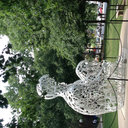Growth and antioxidant responses in Jatropha curcas seedling exposed to mercury toxicity.
Klíčová slova
Abstraktní
Jatropha curcas seedlings were exposed to varying concentrations of mercury in order to investigate mercury accumulation, and the changes in growth and antioxidant enzyme activities using in vitro embryo germination and culture. Our results showed that mercury is readily accumulated by germinating embryos and growing seedlings, and its content was greater in the radicles than those of in the cotyledons and hypocotyls. This accumulation was directly correlated with an increase in tested mercury concentrations in the medium. Biomass in the cotyledons, hypocotyls and radicles increased gradually with increasing mercury concentrations, peaking in seedlings exposed to mercury concentration of 50 microM, and then decreased. Superoxide dismutase activities in the cotyledons, hypocotyls and radicles showed largest increment at mercury concentration of 100 microM. Peroxidase activities in the cotyledons and hypocotyls reached peaks at mercury concentration of 200 microM, and the highest activity in the radicles was observed at 100 microM. Catalase activities in the cotyledons and hypocotyls were significantly induced, and the highest activity in the radicles was observed at mercury concentration of 200 microM. Phenylalanine ammonia-lyase activities in the hypocotyls had a positive correlation to mercury concentrations, and the highest activities in the cotyledons and radicles were found at mercury concentrations of 200 and 100 microM, respectively. Analysis of superoxide dismutase, peroxidase and catalase isoenzymes suggested that different patterns depend on mercury concentrations and tissue types, and the staining intensities of these isoenzymes are consistent with the changes of these enzyme activities assayed in solutions.



